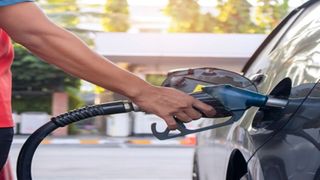
Experts say you should keep your fuel tank at least a quarter full at all times. PHOTO | GETTY IMAGE
|Auto
Prime
It is smart to always have spare fuel
What you need to know:
- If you live in a rural area or take long road trips, having the fuel light start flashing when you are miles from anywhere can be scary. Having extra fuel in the car might just save the day.
- Most vehicles, large and small, now have an economy/tank-size range of more than 600km, and you have to go an awful long way off the beaten track to exceed that without meeting a fuel station.
There was a time when almost all vehicles carried a can of spare fuel. But nowadays, cars are either astonishingly economical or have large fuel tanks, so even long journeys can be completed on a single fill.
Most vehicles, large and small, now have an economy/tank-size range of more than 600km, and you have to go an awful long way off the beaten track to exceed that without meeting a fuel station. So, few boots contain the once ubiquitous “jerrycan”; why carry the weight, or waste the space, or grapple with a heavy lump that could leak and even potentially explode?
Actually, on even quite moderate safaris, there is a strong case to do just that. Your car’s economy/tank range might be ample if all goes well.
But what if the filling station you were relying on has a stock-out; or your tank or fuel lines spring a leak, or your carburetor/injector goes wrong and doubles your fuel consumption?
What if none of those things happen, but the station you fill at puts contaminated fuel into your system?
However, large your car’s tank, and however well within range your journey is, having only one reservoir of fuel on board is putting all your eggs in one basket. A little reserve supply, in a separate container, can make the difference between being disastrously stranded and having no problem.
Spare wheel
Put a little spare fuel in the same category as a spare wheel. Even if you rarely or never need it, it adds to your peace of mind; all the time. And it might help you rescue someone else.
Also, if you use a proper can (not a plastic substitute) it should never leak or pose any difficulty or danger. There is nothing to beat the original “jerrycan”, so called because it was invented by the Germans (“jerries”) to mobilise their armies in the Second World War, (especially in the desert campaigns in North Africa).
It might have been a decisive advantage in the conflict had the other side not urgently captured and copied it. And it was such a masterpiece of engineering that no one has invented anything simpler, surer, safer, stronger and more easily stackable, packable and portable in the subsequent 80 years of technological advance. There are now hundreds of “brands” of jerrycan based on the original 20-litre “Wermachtkannister”, and their quality of material and construction varies, but the basic design is so intrinsically robust and reliable that they are almost all okay.
They are now also made in five-litre and 10-litre sizes. Key features are that they are made of metal; they have only one continuous seam weld (central, not near the vulnerable corners); their “flat” sides are shaped and creased to make them stronger and reduce the pressure of heat expansion; they have hinged caps squeezed shut by a wedge-action lever; and they have three handles (that look like a minature set of cricket stumps).
Those handles symbolise the design genius. See, if you can think up a better way to make a can portable by either one person or two, which is convenient in a bucket-passing chain, and which allows one person to carry four empties, and is symmetrically stackable.





